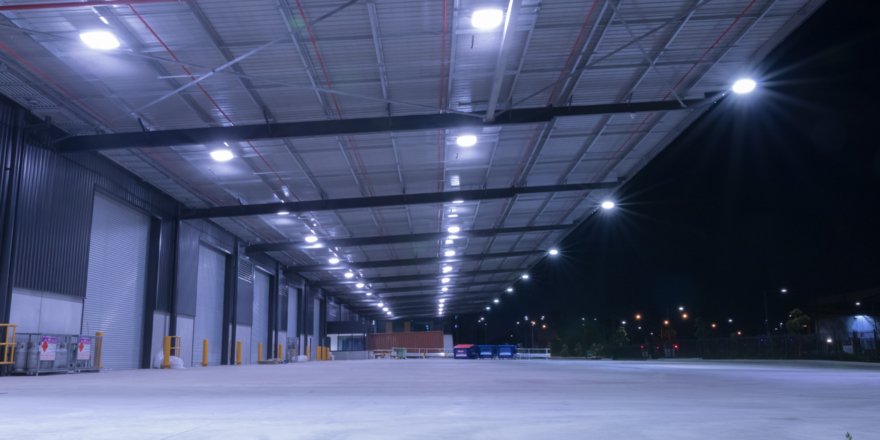How to reduce electricity bills in your company?
Rising energy costs are a concern for every business owner. With rising electricity costs and pressure to increase energy efficiency, plant modernization is becoming a key element of the operational cost management strategy. One of the most affordable solutions is replacing lighting systems, which also brings quick savings and can increase employee productivity by up to 3%.

How to save on electricity?
One of the most effective modernization solutions is to switch to LED lighting. LED light sources are much more energy efficient and have a longer service life than traditional sources, which leads to significant savings in electricity and reduced costs associated with the maintenance and replacement of incandescent, fluorescent or halogen lamps. Possible savings can range from 45% to even 85%.
In general, LED lighting uses much less energy than traditional incandescent or compact fluorescent bulbs, while maintaining a similar level of brightness. For example, a 2x56 W linear luminaire can be replaced with only 42 W LED lighting, which gives an energy saving of 70 W.

Let us consider the specific case of replacing the main lighting of a production hall, where 95 luminaires of 400 W each, drawing 440 W, and 27 fluorescent luminaires of 2x36 W, drawing 80 W each, are used, operating for an average of 8,760 hours per year. It is worth adding that this hall is one of eleven areas of the entire industrial complex, which additionally includes a dozen or so technical and administrative buildings.
Energy consumption before changing to LED:
- Energy consumption per luminaire: 440 W
- Energy consumption per fluorescent luminaire: 80 W
- Energy consumption for all luminaires: 440 W x 95 + 80 W x 27 = 41,800 W + 2,160 W = 43,960 W = 43.96 kW
- Energy consumption per year: 43.96 kW x 8,760 hours = 385,089.6 kWh
Energy consumption after changing to LED:
- 65 ULT3-IV-NW-DGT-90°-HPT-DALI luminaires with a power of 145 W used
- Energy consumption for all luminaires: 145 W x 65 = 9,425 W = 9.425 kW
- Energy consumption per year: 9.425 kW x 8,760 hours = 82,563 kWh
Energy savings after replacing with LED:
- Annual energy savings: 385,089.6 kWh - 82,563 kWh = 302,526.6 kWh
- Assuming an energy cost of EUR 0,27 per kWh, annual savings are: 302,526.6 kWh x EUR 0,27/kWh = EUR 80,992.42
It is also worth noting that these savings will increase as LED technology is developed and more advanced control systems are used, which further reduces energy consumption. In the case of larger industrial facilities, the potential savings are even more significant.
In addition to switching to LED lighting, there are several other ways to save energy directly related to lighting in industrial facilities:
Use of natural light regulation systems
Natural light regulation systems allow for maximum use of available daylight, which further reduces energy consumption. Daylight sensors allow for automatic adjustment of artificial lighting intensity depending on lighting conditions, which contributes to energy savings.
Installing high energy efficiency lighting fixtures
Lighting fixtures with a high Luminous Efficacy (LU) allow for achieving the required brightness with lower energy consumption.
Regular maintenance and servicing
Cleaning and maintaining lighting fixtures, replacing damaged or worn components and checking the correct operation of control systems helps to ensure optimum lighting performance with minimum energy consumption. This not only ensures longer equipment life but also reduces power consumption.
Use of spotlights and directional lighting
Using spotlights and directional lighting allows you to focus light on specific work areas, reducing energy consumption by eliminating unnecessary lighting.
Intelligent lighting control systems
These systems, based on advanced sensor and automation technologies, allow for dynamic adjustment of lighting intensity to actual needs, depending on the presence of people, the intensity of natural light or the time of day:
Time control systems - allow for programming of cyclical lighting schedules, adapted to the opening and closing hours of the facility and work schedules, e.g. programmable systems such as time converters (Time Switches), astronomical clocks (Astronomical Timers), or time control modules (Time Control Modules).
Motion sensor control systems - respond to the presence of people in the room, automatically turning on or adjusting the intensity of lighting depending on activity. Here we can mention, for example, presence detection systems (Presence Detection Systems), active motion detection systems (Motion Detection Systems), or passive infrared motion sensors (Passive Infrared Motion Sensors).
Light sensor control systems - monitor the intensity of natural light and adjust the intensity of artificial lighting to minimize energy consumption.
Building-integrated control systems - this category includes, for example, intelligent building management systems (Building Management Systems - BMS) or automatic lighting control systems (Automatic Lighting Control Systems).
Smartphone or tablet control systems - modern systems allow for remote lighting control using mobile applications. Examples include lighting control systems integrated with IoT (Internet of Things) technology and systems based on communication protocols such as Bluetooth or WiFi.
Traditional or wireless control systems - via cable using the Dali system or wireless using the D4i standard.
Summary
The use of advanced lighting technologies, such as LEDs and intelligent control systems, allows for significant reductions in energy costs, increased operational efficiency and improved working conditions. The effect of these actions is not only cost reduction but also a reduction in the impact on the environment, which is crucial in today's sustainable business.
In addition to direct financial savings, modernization of lighting systems contributes to the improvement of employee productivity, which in the long term brings even greater benefits to companies. According to research, good quality light and optimal intensity increase employee productivity by 1-3%. Implementation of modern lighting solutions is therefore an investment that quickly pays off and brings lasting benefits.